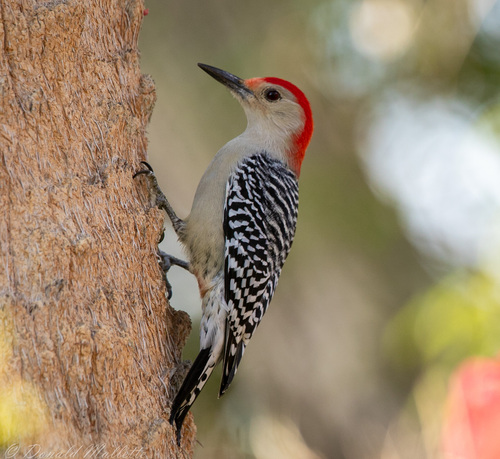
Red-bellied Woodpecker
The Red-bellied Woodpecker (Melanerpes carolinus) is a medium-sized woodpecker common in the eastern United States. Despite its name, the red on its belly is often faint and difficult to see. It is more easily identified by the vibrant red cap and nape on males, and the black-and-white barred back present in both sexes. This species plays a vital role in forest ecosystems by controlling insect populations and creating cavities that are later used by other species for nesting. It is a familiar sight at backyard feeders, adding a splash of color and lively activity.
22-26 cm
Length
38-46 cm
Wingspan
Least Concern
Conservation Status
Distribution
The Red-bellied Woodpecker is primarily found in the eastern United States, ranging from southeastern Canada (southern Ontario) south to Florida and west to the central Great Plains. It does not typically undertake long-distance migrations, though some northern populations may move slightly south in winter.
Lifespan
Up to 12 years in the wild has been recorded, but the average lifespan is likely shorter.
Red-bellied Woodpecker's Habitat
Habitat Types
Deciduous forests, Mixed woodlands, Pine forests, Suburban areas with mature trees, Parks
Climate Zones
Temperate, Subtropical
Adaptations
Red-bellied Woodpeckers have strong, chisel-like bills for excavating wood and extracting insects. They possess zygodactyl feet (two toes pointing forward and two backward) for a secure grip on tree bark. A long, barbed tongue helps them extract insects from crevices.
Variations
Several subspecies have been described, differing slightly in size and plumage intensity, but these are not always consistently recognized.
Appearance
Breeding Plumage
Plumage remains relatively consistent throughout the year.
Seasonal Feather Changes
No significant seasonal changes
Sex Based Plumage Differences
Males have a red crown and nape, while females have a red nape and a gray crown. Both sexes have a black-and-white barred back and wings, and a pale, often slightly reddish belly.
Notable Features
Black-and-white barred back, Red cap and nape (males), Red nape only (females), Long, chisel-like bill
Diet and Feeding
Primary Foods
Insects, Arthropods, Fruits, Nuts, Seeds
Foraging Behavior
Red-bellied Woodpeckers are versatile foragers. They glean insects from tree bark, probe crevices, and excavate wood to find larvae. They also readily consume fruits, nuts, and seeds, often visiting bird feeders. They are known to cache food, storing nuts and seeds in tree crevices for later consumption.
Specializations
Their strong bill and long, barbed tongue are specializations for extracting insects from wood. Their ability to cling to vertical surfaces allows them to access food sources unavailable to many other birds.
Seasonal Diet Variations
Their diet shifts with the seasons. Insects are more prominent in the warmer months, while fruits, nuts, and seeds become more important in the fall and winter.
Behavior
Social Structure
Red-bellied Woodpeckers are generally solitary or found in pairs, especially during the breeding season. They are not typically found in large flocks.
Communication
A rolling 'churr' or 'kwirr' call, A loud, repetitive 'chiv-chiv' call, Drumming on resonant surfaces
Migration
Most populations are non-migratory or only undertake short-distance movements in response to food availability or severe weather.
Territorial or Group Behaviors
Red-bellied Woodpeckers are territorial, especially during the breeding season. They defend their nesting and foraging areas from other woodpeckers and potential competitors.
Conservation
Threats
Habitat loss (due to deforestation and urbanization), Competition with invasive species (e.g., European Starlings for nest cavities)
Protection Programs
General habitat conservation efforts, Protection of mature forests
Local National Laws
Protected under the Migratory Bird Treaty Act in the United States.
Population Trend
Stable
Population Estimates
The global population is estimated to be around 11 million.
Interesting Facts
They can stick their tongue out nearly 2 inches past the end of their beak.
This helps them reach insects deep within tree crevices.
The red on their belly is often faint and difficult to see.
The name 'Red-bellied' can be misleading; the red head markings are much more prominent.
They often store food in tree crevices.
This caching behavior helps them survive during periods of food scarcity.
Red-bellied Woodpecker brains are protected from damage by special adaptations.
These include a spongy bone structure in the skull and a hyoid bone that wraps around the brain, acting as a shock absorber.
Faqs about Red-bellied Woodpecker
What do Red-bellied Woodpeckers eat?
They eat a variety of insects, fruits, nuts, and seeds. They are common visitors to bird feeders, where they enjoy suet, peanuts, and sunflower seeds.
Where do Red-bellied Woodpeckers nest?
They nest in cavities that they excavate in dead trees or dead limbs of live trees.
Are Red-bellied Woodpeckers aggressive?
They can be territorial, especially during the breeding season, and may chase away other woodpeckers or birds from their nesting or feeding areas.
How can I attract Red-bellied Woodpeckers to my yard?
Provide a source of food, such as suet feeders, peanut feeders, or sunflower seed feeders. Leaving dead trees or snags standing (if safe to do so) can also provide nesting habitat. A bird bath can provide a water source. *Consult an expert for safety advice.*
Copyright @ Nature Style Limited. All Rights Reserved.
 English
English